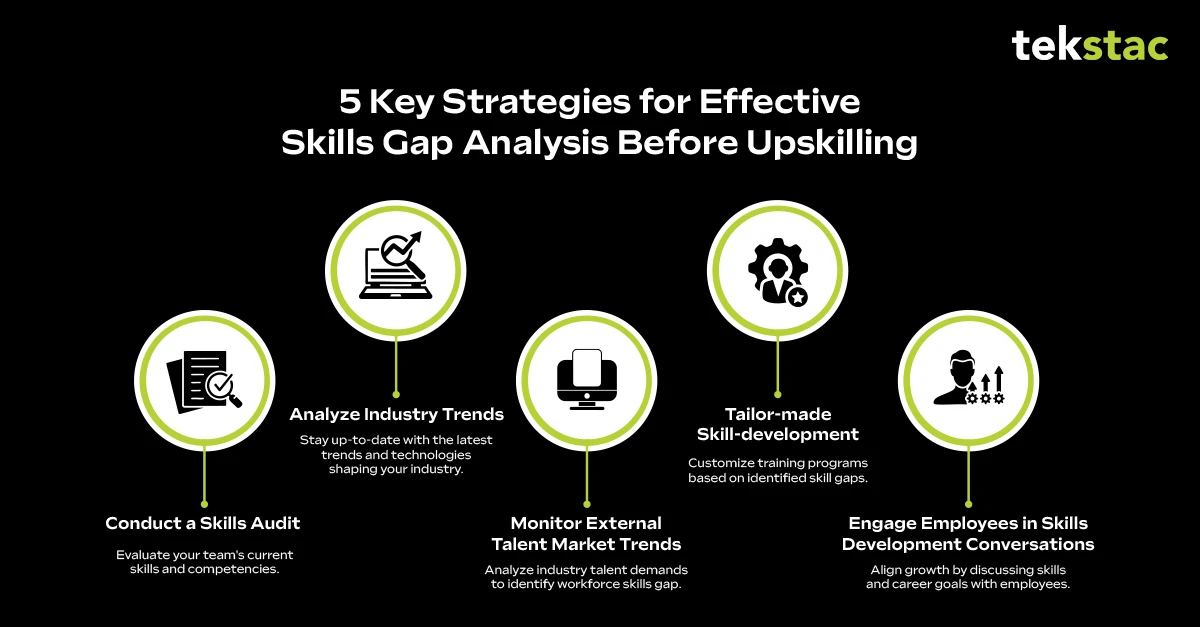5 Strategies for Employers to Conduct Skills Gap Analysis Before Upskilling
November 21, 2024

What is a skills gap?
A skills gap occurs when there’s a mismatch between the skills employees currently have and those needed to meet business objectives. It can negatively affect productivity, growth, and innovation—especially in fast-evolving fields like AI, cybersecurity, and data analytics.
A recent survey by the American Staffing Association (ASA) reveals that many employers are struggling to find talent with the right skill sets.
Identifying and addressing these gaps through a structured skills gap analysis is essential to building a future-ready workforce. By using tools like competency assessments, performance reviews, and employee feedback, organizations can pinpoint deficiencies and develop targeted upskilling strategies that truly move the needle.
Want to dive deeper into the current skills shortages shaping the future of work in 2025?
Explore our full article: What Are the Skills Gaps Employers Are Looking to Close in 2025?
Bridging skills gap
“72% of employers are struggling to find employees with the right skills” says a report from Deloitte on workforce challenges.
Understanding and addressing skills gaps is crucial for designing effective upskilling programs. A thorough skills gap analysis allows organizations to focus on priority areas, ensuring resources are allocated where they can have the most significant impact.
With a clear understanding of these gaps, it becomes possible to develop targeted strategies that strengthen workforce capabilities and enhance adaptability to future challenges. Structured approaches to skills gap analysis and upskilling not only identify areas for improvement but also guide the selection of relevant programs. Aligning these efforts with industry trends ensures the workforce stays competitive and prepared for evolving demands.
5 Strategies for skills gap analysis before upskilling
Organizations can follow various methods to do a skills gap analysis. Here are a few powerful strategies to be followed by employers to identify skills gaps before upskilling.

1. Conduct a skills audit
A skills audit is conducted to assess the current skill set of the workforce and determine whether it is up-to-date. It should be performed periodically to verify the capabilities of each employee and the overall skills of the team.
Consider the following points to do a skills gap analysis using a skills audit strategy.
- Study the latest trend in the market to know the in-demand skills as said earlier and review industry reports.
- Learn what skills the competitors prioritize in the job and employee development programs.
- Assess and check skills gaps regularly and employ a learning solution that allows learners to self-assess their skills and proficiency levels.
- Gather feedback from managers and employees to understand their perspective on training needs. This can be done through interviews, surveys, or group discussions.
2. Understand the current industry trends
To effectively identify skills gap, it’s crucial to stay attuned to the evolving needs of the industry. As industries rapidly embrace digital transformation, emerging technologies such as AI, machine learning, and blockchain are reshaping job roles and required skill sets. Understanding these shifts enables employers to anticipate future skills demands and align training programs accordingly.
Keeping track of industry reports, market forecasts, and competitor developments also provides valuable insights into which skills will be vital in the coming years, allowing organizations to proactively address the gaps before it becomes too late.
3. Monitor external talent market trends
By analyzing the talent pool outside your organization, you can gain a clearer understanding of the skills that are currently in demand. Reviewing job postings from competitors and industry leaders offers a valuable benchmark to compare the capabilities of your existing workforce. This comparative analysis helps highlight areas where your employees may be lacking.
Additionally, understanding the skills required by external candidates ensures that your team remains competitive and aligned with market standards. Monitoring talent marketplace platforms, recruitment reports, and industry salary surveys can provide further insights into the evolving skill demands within your industry.
4. Tailor-made skill-development
The skills audit identifies the difference between current skills and skills required for the new role. By tracking the employees’ performances with KPIs and regular assessments organizations can identify areas for improvement.
AI-powered skilling platforms offer customized skill development solutions tailored to the specific needs of each department and role. Integrating GenAI capabilities within the learning platform has made it easier to design and implement effective upskilling programs that align with individual and organizational needs.
Regular assessments and reports help design personalized training programs. This approach specifically addresses the skills required for each role because a one-size-fits-all approach cannot address the unique skill requirements of different job roles.
5. Engage employees in skills development conversations
Engaging employees in regular career development conversations is essential to identifying skills gaps that might not be evident through formal assessments alone. Many organizations now recognize the value of listening to their employees’ aspirations and career goals. These conversations provide critical insights into where employees feel they need further development.
When employees are asked about their professional growth, they often point to skill gaps that may not be visible through performance metrics. This helps to ensure that upskilling efforts are aligned with what employees actually need, which can increase engagement and motivation.
Moreover, it promotes a culture of continuous learning, as employees take ownership of their growth, and the organization can adjust its upskilling initiatives to support both individual and company-wide goals.
Conclusion
In today’s workplace, identifying skills gap and empowering your team is important to succeed. By adopting the right strategies you can build a workforce that is ready to face future challenges.
Platforms such as Tekstac help organizations perform skills gap analysis more accurately. Leveraging the tools and proactive approaches, businesses can implement effective upskilling programs that promote a continuous learning environment and ensure employees grow with the company.
Remember, upskilling is an ongoing journey.
As the skills and job roles continue to evolve, organizations must remain agile and proactive in identifying emerging trends and adapting their workforce strategies to stay ahead of the curve.
So, don’t wait any further.
Build a capable and resilient future-ready workforce with Tekstac!
Skills Gap Analysis FAQs
1. How often should skills gap analysis be done?
A skills gap analysis can be performed annually or twice a year. It should be a constant process that can be repeated.
2. Which specific areas within the IT sector are facing the biggest skills gaps in 2025?
Cybersecurity, Machine learning, Cloud Migration, and Big Data.
3. How can employers identify the knowledge and skills of employees?
Employers can track their employees’ performances through assessments. By doing periodic skills assessments and skills inferences through various methods, employers can identify individual skills gap and take appropriate measures.





